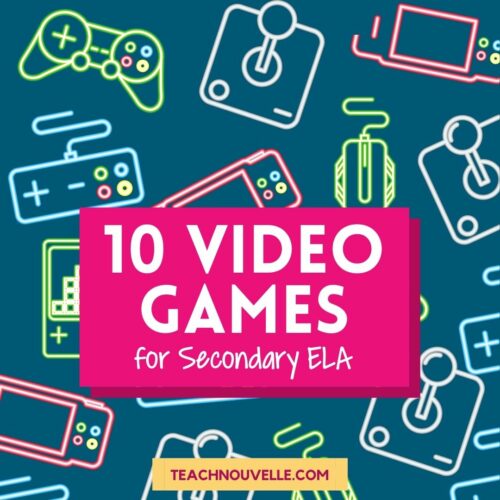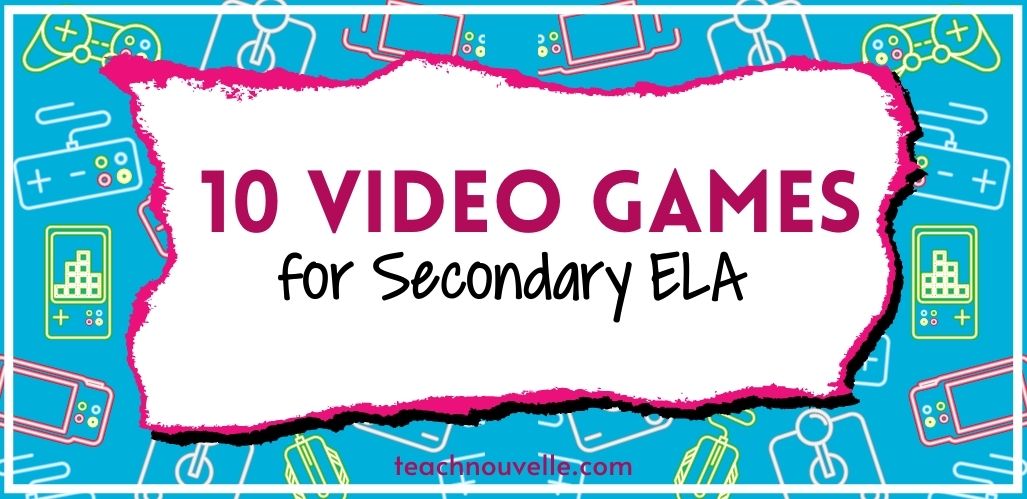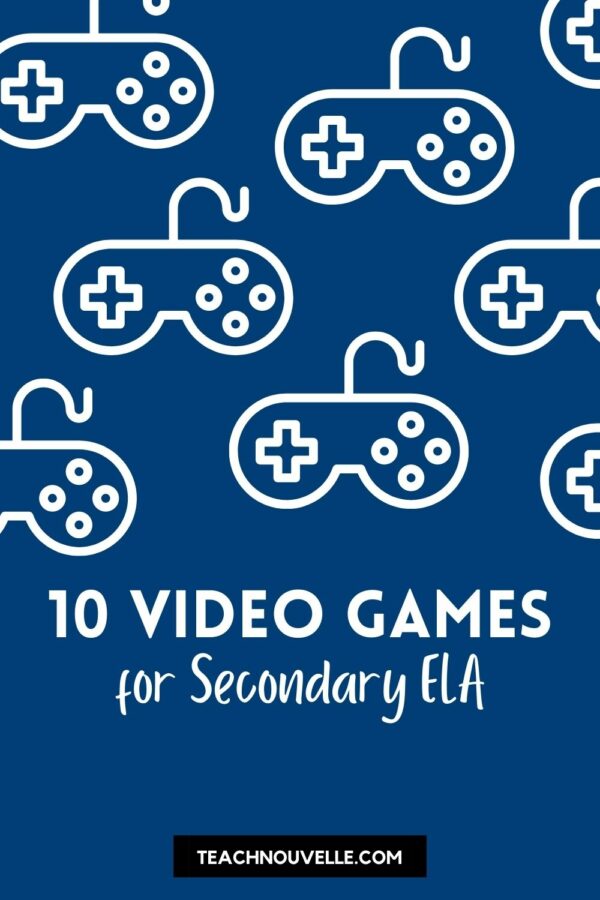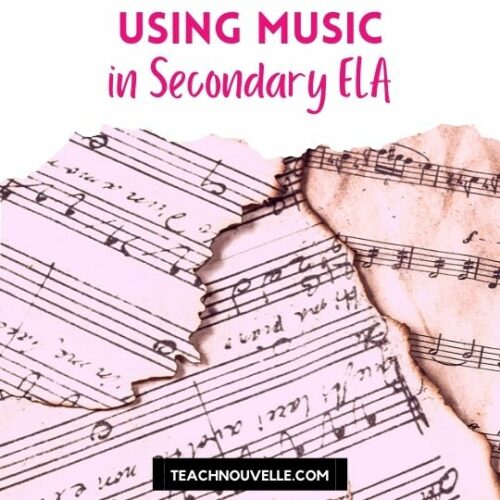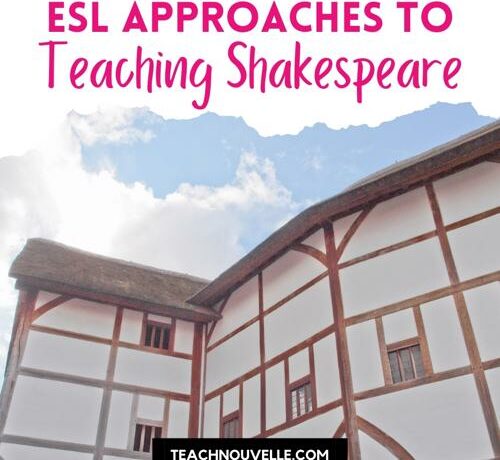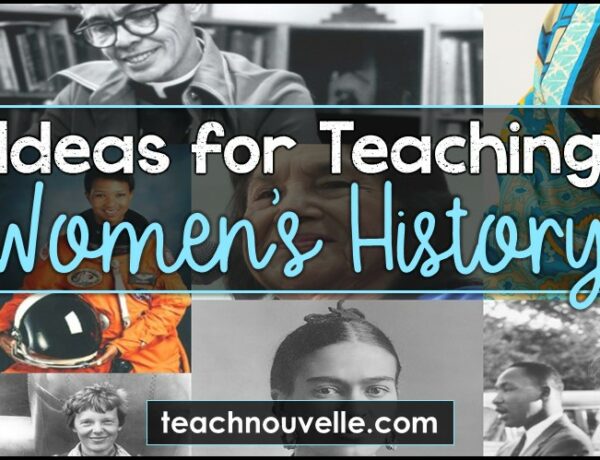Video games can be helpful tools to help students gain a deeper understanding of literature. Here are 10 video games to use in Secondary ELA.
Using video games for mentor texts is a great way to connect with students who are reluctant to analyze elements of literature. Since so many students already love video games, these texts are an excellent way to leverage their interests.
I also have a new resource (2023) that has 15 lesson plans analyzing pop culture short texts, like video games, TV episodes, songs, short films, and more! Check out the 15 Pop Culture Analysis Activities resource here.
Using video games in the classroom
You can harness the goodness and power of video games without turning your classroom into a gaming den. In the blurbs below, I recommend specific scenes you can share. I also make recommendations for larger projects students could do if they’re able to play at home.
Video games are often fully developed stories with long cinematic moments and complex plots. Even in combat and puzzle games, developers use music and art to create the mood. There is also a lot of reading. Video games can be an hour of gameplay to 300+, and there’s a reason your students already love them: they are immersive.
Your students won’t get the MOST out of each game unless they play themselves, but we’ll make do. Students can always continue the game themselves, much like a First Chapter Friday hooks them on a good book.
Let’s look at what we can do with what we have.
10 Video Games to Use in Secondary ELA
Subnautica (Unknown Worlds Entertainment, 2014)
Subnautica is a survival game that takes place primarily underwater on an alien world. The marine species are dazzling! Besides the story (which I won’t spoil), the game unfolds as a building simulation/management game in which players gather resources to upgrade equipment and expand their exploration.
Use the cinematic introduction to Subnautica (2:10) as a mentor text to create high stakes. This can be an excellent mini-lesson for a Writer’s Workshop. How do we figure out what’s happening? (A PDA lets us know we’ve survived a crash.) What is our first obstacle? (We need to put out the fire.) What do we discover when we open the hatch? (The main ship, the Aurora, has crashed and has zero human life signs. We are all alone.)
Uncharted 2: Among Thieves (Naughty Dog, 2009)
Uncharted 2 is an action-adventure treasurer hunter game. It has combat and puzzles, but a huge part of the game is sweeping cinematic scenes. It truly watches like a movie. The main character, Nathan Drake, is snarky, funny, and dashing.
The intro scene to Uncharted 2(8:34) is another adventure in creating stakes. Nathan wakes up, shot, in a train, and quickly discovers that the train car is dangling from a cliff. Stuff goes from bad to worse, and we root for Nathan as he climbs to “safety.” You could also use this scene to talk about epigraphs, since this game opens with a quote from Marco Polo. Does the epigraph suggest any themes? What will the game be about? What questions linger after this scene?
P.S. The rating on the entire game is 16+, but the intro is totally fine for middle school.
Stardew Valley (Eric Barone, 2016)
One single developer created this idyllic farming game, and it has since taken the world by storm. The gameplay centers on growing cool stuff and being a great neighbor to your new friends in Stardew Valley.
You can show the opening scene of Stardew Valley(4:27) to model juxtaposition. Your character starts in a dead-end cubicle job working for Joja Mart. The colors are muted and grim. Finally, you “feel crushed by the burden of modern life” and open an envelope from your grandfather. Surprise, he left you a farm in the far-off land of Stardew Valley. You hop on the bus and you’re on your way! Stardew is full of bright colors, neighbors with likes and dislikes, and fun festivals.
Journey (Thatgamecompany, 2012)
Journey is a beautiful, wordless adventure game that you can use for several purposes. There aren’t specific scenes I want to share here, but you can watch the opening scene of Journey(1:31) to get a feel for it. Journey is excellent for nonverbal storytelling. You could use it to develop narrative with English Language Learners in ELL, since there’s not a load of reading to do in the game. Instead, students can develop their vocabulary for mood, tone, and plot.
The Legend of Zelda: A Link to the Past (Nintendo, 1991)
Okay, this is an older game, but the opening scene of A Link to the Past(2:35) is a great mentor text for mood & tone. What are the stakes? How do we know? It’s always great when a story opens on a rainy day, and this game is no exception.
Horizon Zero Dawn (Guerrilla Games, 2017)
This is an action role-playing game where the action unfolds on a futuristic Earth where tribes battle robots. This is a vast oversimplification for this open-world game that is so expansive. There are spears and ceremonies and the Old Ones, but there are also terrifying machine animals and artificial intelligence.
They released the sequel in 2021, and it’s likely you have students who have played one or both. As you watch the opening scene of Horizon Zero Dawn (5:30), consider how the setting and characters impact the mood. We are introduced to a tribalistic world and our main characters are an outcast and the “cursed” baby he cares for. As we witness the Naming Ceremony, we get hints of the conflict about to unfold.
Ask your students: What do we learn about these characters (through direct and indirect characterization)? What do we learn about this society? What hints in the scenery do we see that show this world is more than it seems? This last question provides a significant challenge for your students who may have played the game – what did they notice in this opening that they missed during their first time through?
Return of the Obra Dinn (Lucas Pope, 2018)
In this puzzle adventure game, you, playing as an insurance inspector for the East India Company, have to figure out what happened on the last voyage of the Obra Dinn. The merchant ship, last seen five years ago, has returned off the coast of England with no survivors. The adventure unfolds in a non-linear way and is basically one big logic puzzle. We must attach names and roles (Boatswain, Cook, Captain) to corpses we find aboard.
It sounds gruesome, but the style helps tame this. You do everything in black and white dithering to emulate old computer games and the game mostly unfolds in still images. However, you do your detective work by using a pocket watch that time travels to the last moments of the crew and passengers’ lives. So yeah, not absent of violence.
Return of the Obra Dinn takes about 8 hours to play and has a lot of logic and reading. I would recommend this to students who like mystery and adventure. This would be an excellent text for homeschooling or for an extended project. Students really need to play the entire game to “get it.”
The Legend of Zelda: Ocarina of Time (Nintendo, 1998)
Another Zelda game? Yes! This universe is rich and expansive, and there’s a lot to see. I recommend showing Link retrieving the Master Sword and meeting the sage Raura (stop at 5:40 in the video).
This scene corresponds to Crossing the Threshold in the Hero’s Journey cycle. Up til now, Link has been a kid, running around Hyrule and getting the keys to the Door of Time. Little did he know that the evil Ganandorf was waiting to gain entry to the Temple of Time through Link’s hard work. Once Link (and Ganandorf) entered the Temple, Rauru put Link to sleep for seven years so that he could wake up and fight Ganandorf in an adult body. In that seven years, however, Ganandorf has been growing more powerful and changed the face of Hyrule.
In Crossing the Threshold, our hero enters an unknown world (the Hyrule we just ran around in, but much changed from the darkness of Ganandorf’s tyranny) and faces new enemies.
I also love teaching the Hero’s Journey by analyzing superheroes. Also a topic that’s sure to be popular with students!
Final Fantasy X (Square, 2001)
The Final Fantasy series is another expansive franchise, like Zelda, with many plots, timelines, and recurring entities. It is a fantasy/action RPG.
In FFX, the huge whale-like beast Sin is the main antagonistic force of the game, threatening the world of Spira. You can use the scene where Yuna sends souls to the Farplane after a giant battle to talk about setting, character, and foreshadowing. This is a beautiful scene, but it also introduces an important lapse in our main character’s (Tidus) understanding of Yuna. The other characters in the party say “Yuna knew what she signed up for,” but we don’t yet understand that.
Outer Wilds (Mobius, 2019)
Okay, best for last. Outer Wilds is an exploration game in which our little alien character explores a small solar system. You are a young Hearthian on your first launch into the solar system. However, you are the first Hearthian to make this journey with a translating device, allowing you to be the first adventurer to learn about the Nomai culture that existed in the solar system before your species.
I don’t want to ruin anything about this game, so I’ll tell you a few general things. This is a non-linear mystery game. After taking off from Timber Hearth, you can explore any planet in any order. You’ll get small cues from landmarks on various planets, and exploring them will lead you to texts from the ancient Nomai. Eventually, you’ll understand that there is a story you want to unfold. This game is driven by your curiosity.
This game is SO CHARMING and tugs at all the heartstrings! It can be suspenseful, particularly as you explore less-friendly planets. However, there is no combat.
I hope you and your students play this game. The total game takes about 20 hours, but it is so worth it. This is a fantastic candidate for a homeschooling or enrichment project. Players learn about characters through letters and texts and they have to make inferences.
Books for kids who like video games
There is a LOT of reading in most video games. Additionally, kids are constantly working on their logic, sequencing, and perseverance. It takes immense sequencing to keep track of the dominant story while engaging in all the little side quests villagers may ask you to do. It takes perseverance to take down the Final Boss. These are all excellent skills.
Check out this list of book recommendations for kids who like video games. You might also like my post on making successful book recommendations to teens.
Final thoughts:
I hope this list of video games to use in Secondary ELA has given you some new ideas. My goal was to make it so that even if you’ve never played video games before, you’ll now feel comfortable using at least one of these examples.
Have you ever used video games in the classroom? I want to hear about it! Want to use one of these ideas but need some extra support? Let me know! Comment below or reach out on IG @nouvelle_ela 🙂
Happy teaching!

